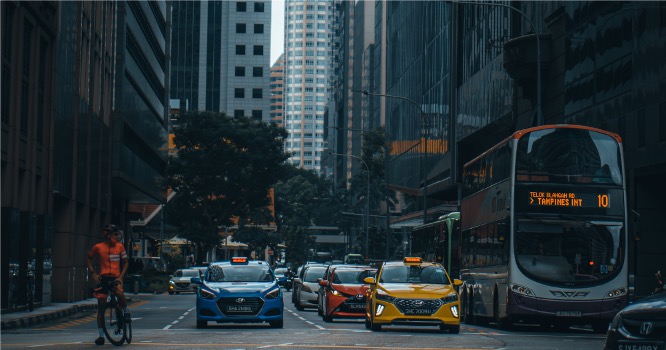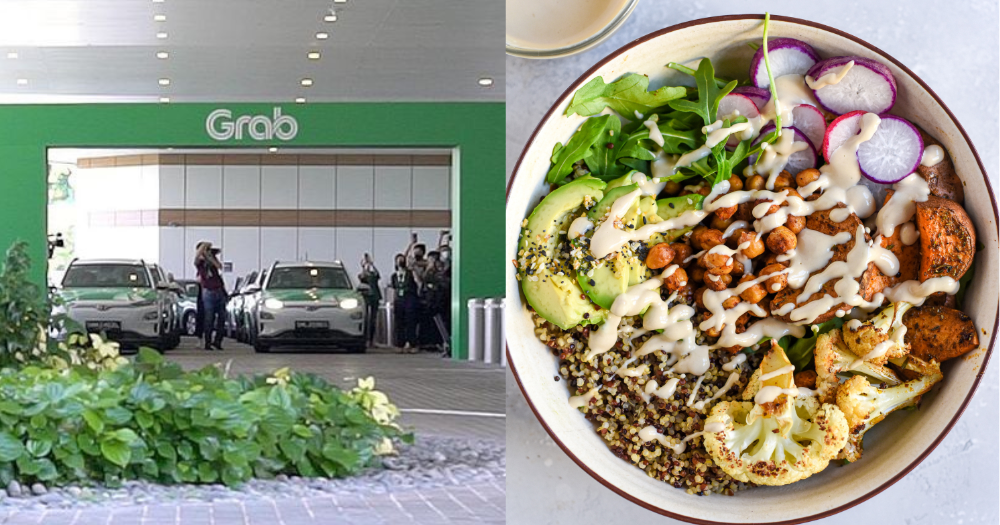Follow us on Telegram for the latest updates: https://t.me/mothershipsg
Picture this scene in a coffeeshop:
"Eh uncle, why my mentaiko salmon soba bowl so expensive today?"
"Aiyah, boy, surge pricing lah. You come at peak hour, plus we got fewer cooks today."
As a customer at this grain bowl stall, you're kind of annoyed about the situation.
When the stall first opened in the coffeeshop, it quickly became a hit because it offered affordable grain bowls that could be ordered for pick-up on demand, with attractive opening pricing.
You thought you would give it a try since you didn't want to queue for your usual cai fan. It was affordable, but you were sick of having it all the time anyway.
Long story short, you became a loyal customer, and the grain bowl stall grew into a sizeable franchise and a mainstay in the coffeeshop.
However, over the years, you notice the prices at the grain bowl stall have steadily increased, their promotions are now a fraction of what they used to be, and their takeaway service now has lengthier waiting times.
It's no longer just Grab-n-Go.
Honestly, the cai fan stall looks tempting now. The queue is slightly faster than what it used to be, the number of offerings at the stall have increased, and prices are still affordable despite yearly price hikes.
So what would you do?
- Would you just eat cai fan to save money?
- Would you complain to the landlord?
- Or would you stick it out as a loyal customer and hope things get better at the grain bowl stall?
Not an easy decision.
POV: You're a regular ride-hailing app user
I think you might get what I'm trying to drive at here.
Let's imagine the ride hailing industry is the grain bowl stall, which provides a platform for cooks (drivers) to provide meals (transport services).
You could also get meals from the other stalls, such as the cai fan stall (public transport) selling affordable everyday fare.
You're quite sure that cai fan will never go out of business, since the landlord (Government) who sets the rules has a close relationship with the cai fan stall.
You could also go to the Hokkien mee stall (taxi services) that's been around for years. The uncles there used to only take your orders when you waved your hand at them, but now they take orders on an app too.
And you can still sometimes get a pretty good price at the grain bowl stall when newer products are introduced, like the Indonesian BBQ dishes (Gojek), for example.
Using this coffeeshop analogy, we will take a closer look at how ride-hailing has evolved over the years, and consider the implications for commuters and drivers moving forward.
Mothership also spoke to Walter Theseira, an associate professor of Economics at the Singapore University of Social Sciences, for his insights on the ride-hailing industry as a whole.
Grain bowl stall shakes up the coffeeshop with huge promos
At the start, no one would have expected to see a grain bowl stall in the coffeeshop, or that it would do so well.
Its secret? Offering ludicrous promotions to get customers on board.
At some points, the price of a grain bowl was effectively not much higher than a plate of cai fan, which as anyone would tell you, is a great deal.
In a similar fashion, operators like Grab and Uber aggressively expanded in Singapore from 2013 by offering convenient point-to-point transport at unbeatable prices.
They enticed customers by subsidising the matching service and recruited drivers by providing attractive incentives.
And to lower waiting times, they tapped on a pool of less regulated vehicles and drivers, while leveraging technology to match drivers and riders efficiently. As expected, ride-hailing became a huge hit with commuters.
In fact, ride-hailing expanded so quickly in Singapore that before two years had passed, more than 2,000 traditional taxis lay idle. Many cabbies had given up driving taxis, primarily due to fierce competition from ride-hailing companies.
However, the main strength of these operators, in being able to tap on less-regulated drivers and vehicles, would soon be called into question.
In November 2015, the National Taxi Association sent a report to the Ministry of Transport (MOT) demanding greater regulation for the ride-hailing industry to "level the playing field" and "ensure the safety and security of commuters".
But that didn't stop Grab, who proceeded to pull off an even more controversial move three years later.
Grain bowl stall crowns itself king of the coffeeshop, but Landlord steps in
In March 2018, Grab acquired the South-East Asia operations of its strongest rival, Uber.
As part of the merger, Grab migrated all of Uber's customers, drivers, merchants, and delivery partners onto its platform.
This would result in Grab dominating the ride-hailing market with a whopping 80 per cent share.

- Image via Grab website.
This was a worrying turn of events, as lawmakers warned that Grab monopolising the market would be "to the detriment of commuters and drivers". Why?
As the major ride-hailing operator, Grab would have the power to raise the prices of rides, extract higher commissions from drivers, or reduce incentives, without fearing too much competition from its rivals.
Well, that's where the landlord stepped in.
In September 2018, MOT responded to this "anti-competitive merger" by banning Grab from making arrangements where drivers and taxi fleets have to exclusively provide services for its platform.
This meant that ride-hailing operators would have to compete fairly for the services of drivers moving forward. If Grab did not provide sufficient incentives for drivers to use their platform, they could easily jump ship to other operators, like the up-and-coming Gojek.
Grab was also required to maintain their pre-merger pricing structure and driver commission rates.
To further crackdown on the industry, the Land Transport Authority of Singapore (LTA) introduced new regulations for the ride-hailing industry to align them with traditional taxi services, in October 2020.
Recognised jointly as the Point-to-Point (P2p) Transport Sector, operators:
- Had to follow a more stringent eligibility criteria when recruiting drivers
- Had to use licensed vehicles
- Were subject to higher safety and service standards
It was a big statement that the government would step in to protect the rights of drivers, and the safety of riders.
However, the ride-hailing landscape would then be rocked by an unexpected disaster - the pandemic.
The coffeeshop's Dark Ages, and why are grain bowls so ex now?
In many ways, the Covid-19 pandemic marked the Dark Ages of the coffeeshop.
Mandatory work-from-home and the lack of tourists drastically shrank the income of P2P drivers.
As a result, many left the industry in search of better job prospects.
When commuters returned to work, they did so in force. The surge in demand, coupled with fewer ride-hailing drivers, led to the problems we experience today — higher fares and longer waiting times.
 Image courtesy of Jeremy Kwok on Unsplash.
Image courtesy of Jeremy Kwok on Unsplash.
Unfortunately, we shouldn't expect prices to drop any time soon given the rise in operating costs from petrol prices and car rental fees.
In fact, we should expect the price of ride-hailing to rise even further in the long run, since the drivers deserve a fair wage, says Theseira, who counts transport among his research interests.
Would having more drivers solve the price issue? Not really.
If there are too many drivers offering their services, but not enough demand from commuters, the platform is likely to offer the rides at a discounted rate. Since this means fewer earnings for drivers, they will likely be upset and reconsider if they still want to drive for the platform.
Theseira adds that we should not expect services provided with labour — like ride-hailing — to remain cheap, especially in a high-income country like Singapore.
He predicts that the industry will contract as wages increase and as fewer people are able to afford ride-hailing on a regular basis.
Oof.
That said, if grain bowls get pricier, there are other options we could go for in the coffeeshop.
Back to cai fan I guess?
The landlord has plans to expand the cai fan stall.
They are going to provide more options to customers and cut the waiting time involved. This stall, designed to provide affordable meals to customers, has always been the landlord's priority.
This intent is reflected in LTA's 2040 Master Plan, which aims to ramp up and improve Singapore's public transport network, to make it far more efficient for commuters across the island to travel to the city or the nearest town centre.
Theseira predicts that Singapore is moving towards a public transport model similar to Tokyo, where efficient subway networks bring commuters most of the way to their destination.
From the subway stations they alight at, they can cover the remaining distance by walking, cycling or taking a bus.
 Tokyo Subway map - via Tokyo Metro website.
Tokyo Subway map - via Tokyo Metro website.
That said, Theseira expects that ride-hailing in Singapore will continue to occupy a niche in the transport sector, albeit a shrinking one.
"Ideally, just like in Tokyo, people wouldn't take it on a day-to-day basis, but only when they need to. Most of the time, they should find their needs better met by public transport," he predicted.
Presently, ridership on public transport has already recovered to more than 80 per cent of its pre-pandemic levels.
In the future, it looks to be even more convenient, so we may not feel the need to "Grab" quite as often.
The cook's story
Now, you, the customer, might wonder, "Hey, Grab prices are so ridiculous right now! Will they ever go down?"
But the drivers might say, "I need to earn too! Petrol prices and car rental fees are increasing, you know?"
There's always two sides to the story.
 Image by Tom Morbey on Unsplash.
Image by Tom Morbey on Unsplash.
Taking a step back, it is clear that ride-hailing drivers who survived in the industry had to adjust to using technology and pivot to different services and operators in order to stay afloat.
That said, is it sustainable as a career?
One significant change is the CPF regulations that will come into play in 2024, which means that drivers will see a reduction in their take-home pay. If that is the case, other forms of skilled work, such as technician jobs, could become more appealing — particularly in sectors where the Progressive Wage Scheme is applied to uplift workers' skills and salaries.
Theseira adds that the government has no interest in having the ride-hailing industry too large, and could impose regulations restricting the number of riders or vehicles for ride-hailing, similar to what they did for taxi companies in the past.
He thinks that the government doesn't necessarily want to encourage young people to pursue ride-hailing as a career, as it can impede long-term career mobility and the long hours involved can take time away from upskilling pursuits.
The good news for ride-hailing drivers is that the government has made a conscious effort to upgrade the wages of low-wage workers in Singapore, so these drivers may have the opportunity to move to greener pastures.
That said, some may choose to stay in the industry because of the flexibility it gives them as a self-employed freelancer, and the freedom of being their own boss.
Being a P2P driver is also something that people can do if they are retrenched or can’t get a regular job.
The future of the grain bowl stall?
So what does the future look like for the ride-hailing industry, for drivers, and for consumers like you and me?
Theseira reiterated that in the long term, he expects a contraction in the ride-hailing industry. This development would be "healthy", as the redirection of commuters to public transport will be more economically efficient.
"People will remember a time when ride-hailing, due to the large subsidies involved, was actually taking away business from public transport," he said, calling that phenomenon "grossly economically inefficient".
"There is no reason why that should ever happen. There were too many P2P vehicles [then], but now it's trending towards a more reasonable number," he explained.
He thinks that many ride-hailing drivers are unable to get the pay they want in other jobs.
Meanwhile, the government's priority is to try to funnel these (and other) workers towards higher-skilled work. Theseira explains:
"I think the problem is that other jobs don’t pay the pay that they should. So that needs to be worked on, and the government is [indeed] trying to upgrade the wages for these skilled jobs."
While ride-hailing prices may remain high for consumers, Theseira thinks it is necessary so that the drivers are paid a fair wage.
"It’s a job that has a lot of dignity to it, and should be paid reasonably," he concluded.
As a consumer myself, my (GrabPay) wallet and I were not thrilled to hear his predictions.
However, I couldn't argue with his logic, or his principled take on fair wages.
And worst come to worst, I guess I could always just eat cai fan.
Top image via Grab on FB / courtesy of Caroline Green on Unsplash.
If you like what you read, follow us on Facebook, Instagram, Twitter and Telegram to get the latest updates.
